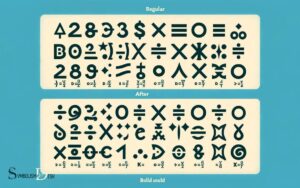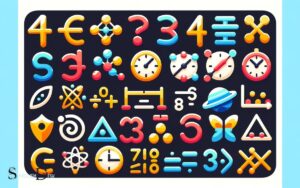What Is the Math Symbol for Congruent? Figures!
The math symbol for congruent is ≅. In geometry, congruence is a relation that indicates two shapes, figures, or angles are identical in shape and size.
When two objects are congruent, all corresponding sides and angles are equal. The symbol used to denote congruence is ≅, which is essentially an equals sign with a tilde above it.
For example, if triangle ABC is congruent to triangle DEF, mathematicians write this as △ABC ≅ △DEF.
Here are the key points about congruence and its symbol:
In geometry, the ≅ symbol is fundamental, representing the exact equivalence in size and shape between two geometrical figures.

Key Takeaway
Understanding Congruence in Mathematics
Understanding the concept of congruence in mathematics is essential for a thorough grasp of geometric principles and their applications. In geometry, two figures are considered congruent if they have the same shape and size.
This means that one figure can be transformed into the other through a combination of translations, rotations, and reflections.
Congruence is denoted by the symbol ≅, which signifies the equality of the corresponding parts of the two congruent figures. It is crucial to comprehend the properties and implications of congruence, as it forms the basis for various geometric proofs and constructions.
Moreover, congruence allows mathematicians to make precise comparisons between different shapes and objects, enabling accurate calculations and measurements in various fields such as architecture, engineering, and design.
Understanding the importance of the congruence symbol provides a solid foundation for further exploration into the realm of geometric relationships and transformations.
Importance of the Congruence Symbol
The congruence symbol holds significant importance in mathematics as it serves as a symbol of equivalence, indicating that two geometric figures are similar in shape and size.
It plays a crucial role in representing geometric similarity and conveying mathematical congruence, providing a concise and powerful notation for expressing equality in shape and size between figures.
Understanding the importance of the congruence symbol is fundamental in various mathematical concepts and applications, emphasizing the precision and clarity it brings to mathematical expressions.
Symbol of Equivalence
The congruence symbol, denoted by ‘≅’, is an essential tool in mathematics for expressing the concept of shape or size equivalence between geometric figures. It signifies that two figures are congruent, meaning they have the same shape and size.
This symbol holds significant importance in geometry, as it allows mathematicians and students to denote when two shapes are identical in all aspects, ensuring precision and clarity in mathematical expressions.
The symbol of equivalence is crucial in geometric proofs, as it helps in stating that two figures can be superimposed onto each other, demonstrating their congruence.
Its usage extends beyond geometry, finding application in various mathematical fields where the equivalence of shapes or sizes needs to be denoted.
Therefore, the congruence symbol plays a fundamental role in mathematical communication and reasoning.
Geometric Similarity Representation
An essential aspect of geometric representation, the congruence symbol holds significant importance in conveying the similarity between geometric figures.
This symbol, often represented as ≅, plays a crucial role in geometric similarity representation for several reasons:
- Visual Representation: The congruence symbol provides a clear and concise visual representation of the equality of shapes and sizes, aiding in the comparison of different geometric figures.
- Mathematical Clarity: It helps mathematicians and students to express geometric similarity in a standardized and unambiguous manner, ensuring clarity in communication and understanding.
- Theoretical Framework: The symbol forms the basis for the study of geometric similarity and lays the groundwork for advanced geometric concepts and theorems.
Understanding the significance of the congruence symbol is essential for delving deeper into the mathematical congruence indication.
Mathematical Congruence Indication
One crucial aspect of the congruence symbol is its pivotal role in conveying the equality of geometric figures, providing a standardized indication of their similarity.
In mathematics, the symbol for congruence, ≅, signifies that two or more geometric shapes are identical in shape and size.
This symbol is essential for indicating when two figures have the same dimensions and angles, despite potential variations in their orientation or position.
By using the congruence symbol, mathematicians and students can express geometric relationships precisely and concisely, avoiding the need for lengthy verbal descriptions.
This standardized notation is particularly important in geometry, where clear communication of the equality of shapes is fundamental to understanding and solving geometric problems.
The congruence symbol thus plays a vital role in ensuring accurate geometric comparisons and calculations.
History and Evolution of the Congruence Symbol
The history and evolution of the congruence symbol dates back to the geometric and mathematical developments of ancient civilizations. Understanding its evolution provides insights into the progression of mathematical notation and the development of geometric concepts.
Here are some interesting points to consider:
Ancient Greek Influence:
- The concept of congruence was first formalized by ancient Greek mathematicians.
- The use of geometric shapes and figures to establish congruence laid the foundation for symbolic representation.
Symbolic Evolution:
- The evolution of the congruence symbol from its early geometric representations to its current symbolic form showcases the development of mathematical notation.
- The symbol has undergone refinements over time to become the widely recognized notation for congruence.
Cross-Cultural Development:
- The symbol for congruence has been influenced by various cultures, reflecting the global evolution of mathematical concepts and notation.
Using the Congruence Symbol in Equations
How can the congruence symbol be effectively utilized in mathematical equations?
- The congruence symbol, denoted as ≡, is used to show that two mathematical expressions or geometric figures are congruent, meaning they have the same size and shape.
- In equations, the congruence symbol can be used to express that two sides, angles, or shapes are equal in measure or size.
- It allows for the concise representation of geometric properties and relationships within equations.
- When used in equations, the congruence symbol simplifies the communication of geometric concepts and properties, making it easier to express and solve geometric problems.
Applications of the Congruence Symbol in Geometry
The concept of congruence in geometry plays a crucial role in various applications, particularly in the context of points. Understanding how points can be congruent allows us to explore the relationships between different geometric figures and their corresponding points.
From triangle congruence proofs to geometric transformations, the congruence symbol provides a powerful tool for analyzing the equality of points in geometric configurations.
Triangle Congruence Proofs
Triangle congruence proofs demonstrate the equality of corresponding sides and angles in different triangles. These proofs are fundamental in geometry and have practical applications in various fields.
Here’s why they matter:
- Understanding spatial relationships: Triangle congruence proofs help us understand how different triangles can be positioned and oriented relative to each other.
- Real-world applications: From architecture to engineering, these proofs are used to ensure that structures are built accurately and can withstand various forces.
- Problem-solving in mathematics: Mastering triangle congruence proofs enhances problem-solving skills and lays the foundation for advanced geometric concepts.
Congruent Angles and Sides
Congruent angles and sides play a crucial role in demonstrating the equality of corresponding elements in geometric figures, continuing the discussion from the previous subtopic of triangle congruence proofs.
When two angles or sides in different figures are congruent, it means they have the same measure or length, respectively.
In triangles, for example, if two angles in one triangle are congruent to two angles in another, the third pair of angles must also be congruent, ensuring that the two triangles are similar.
Similarly, if the three sides of one triangle are congruent to the three sides of another, the triangles are congruent. This concept is fundamental in establishing the relationships between different geometric shapes and their elements.
Understanding congruent angles and sides enables comprehensive analysis of geometric configurations, paving the way for further exploration into geometric transformations and congruence.
Geometric Transformations and Congruence
Geometric transformations and congruence’s applications in geometry are fundamental for understanding the relationship between different geometric shapes and their elements.
When exploring this topic, it’s important to consider:
- Translation: Understanding how congruence is preserved when an object is moved without rotation or resizing.
- Reflection: Exploring how congruent figures result from flipping a shape over a line.
- Rotation: Examining how congruence is maintained when a figure is turned about a point.
These transformations play a vital role in geometry, allowing us to identify and understand congruent shapes in various orientations. They also form the basis for more advanced geometric concepts.
Congruence Symbol in Mathematical Proofs
In mathematical proofs, the congruence symbol, denoted as ≡, is used to assert the equality of geometric figures with respect to their size and shape.
When employing this symbol in mathematical arguments, it signifies that the corresponding parts of the geometric shapes are congruent, meaning they have the same measures and are identical in shape.
This symbol plays a crucial role in geometric proofs, enabling mathematicians to demonstrate the equality of angles, sides, and other properties of geometric figures.
By using the congruence symbol, mathematicians can logically justify the equality of geometric elements, thereby reinforcing the validity of their mathematical arguments.
Understanding the significance and application of this symbol is essential for effectively communicating geometric proofs.
Teaching Congruence and the Symbol in Education
Education on the concept of congruence and its symbol is essential for fostering students’ understanding of geometric principles and their ability to construct mathematical proofs.
When teaching congruence and its symbol in education, it’s important to:
- Provide visual aids and interactive activities to help students grasp the concept of congruence and the symbol representing it.
- Utilize real-life examples to demonstrate the practical applications of congruence in various fields such as architecture, engineering, and art.
- Incorporate technology and online resources to engage students and enhance their understanding of congruence and its symbol through interactive simulations and virtual manipulatives.
Conclusion
The congruence symbol in mathematics holds immense significance, with its origins dating back to ancient geometric principles. Its use in equations, proofs, and geometry applications showcases its versatile nature.
Teaching and understanding the symbol is crucial in the field of mathematics. The symbol serves as a powerful tool in demonstrating equality and similarity, making it an indispensable element in mathematical education and problem-solving. Furthermore, the use of symbols fosters a universal language that transcends linguistic barriers, enabling students from diverse backgrounds to engage with mathematical concepts. By grasping the w symbol meaning in mathematics, learners can better comprehend complex relationships and operations, ultimately enhancing their problem-solving skills. This symbolic understanding not only aids in academic success but also cultivates critical thinking and analytical abilities that extend beyond the classroom.






